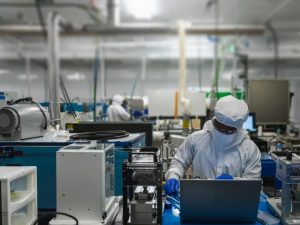
Solid-state batteries, with no liquid electrolyte, have been (like fleets of hydrogen cars) just around the corner for a long time. But commercialization is finally approaching, the companies say, and along with advantages over traditional lithium-ion in safety, weight and energy density, add a potential ability to fast-charge regularly with reduced battery damage.
The San Jose, California-based QuantumScape recently released data indicating that its battery cells with ceramic solid-electrolyte separators (made from what it said are “earth-abundant materials”) had gone through 400 cycles of 10 to 80 percent fast charging (the equivalent of covering 160,000 miles). And they retain, according to QuantumScape Chief Marketing Officer Asim Hussain, “well over 80 percent of their capacity at a variety of temperatures.” These temperatures ranged from 25 degrees Centigrade (77 degrees Fahrenheit) to 45 Centigrade (113 Fahrenheit), the company said.
He said that the company is aiming for such charges to take 15 minutes, compared to 20 to 25 minutes for conventional lithium-ion power cells. The latter, Hussain said, “are just not designed for repeated fast charging.”
According to a QuantumScape white paper, “Repeated fast-charging [of legacy lithium-ion batteries] results in degraded cycle life due to multiple effects: loss of lithium due to reactions on the surface of the graphite particles in the anode, as well as accelerated degradation stemming from the elevated temperatures that result from the high current densities required for fast charge in energy-dense cells.”
QuantumScape is targeting 2023 to produce battery samples that can be used in test cars, and 2024 to 2025 for commercialization, which it defines as cells that can be sold to a third party.
Autoweek wrote in April about battery degradation in today’s EVs when they reach high mileage, such as a 200,000-mile Tesla Model S with just 100 miles of effective range. It’s a real phenomenon, that maybe solid-state can address. BMW and Ford are major investors in Colorado-based solid-state company Solid Power, which claims a 50 to 80 percent increase in battery energy density over conventional li-ion.
Solid Power tested its high content silicon anode cells with a regimen of fast charging every fifth cycle, and found 81 percent capacity retention after 650 cycles. The company said fast charging every fifth cycle “is more in line with consumer behavior.” Solid Power also expects its lithium metal anode solid-state batteries to last 369,000 miles and more than 1000 cycles.
Solid Power said in an email that it is anticipating silicon EV cell production in 2025, with vehicles using those batteries coming out a year later in 2026.
Sam Abuelsamid, principal research analyst at Guidehouse Insights, said in an interview about the solid-state battery claims, “It depends to some degree how you conduct the testing. What damages batteries during fast charging is heat, and if you’ve got one cell on a bench, fast charging and then discharging, you can control the temperature for that very well. So I’m not sure how representative that would be.”
Abuelsamid added, “In theory, there is some potential for solid-state batteries to reduce fast-charging degradation because you don’t have dendrites forming. But there are a lot of variables. I would say that solid-state is not going to be the magic bullet solving degradation, but it could be a factor that helps.”
Solid-state batteries are a waiting game. It’s possible Toyota will be the first OEM to market. Gill Pratt, the company’s chief scientist and head of the Toyota Research Institute said early this year that the company hoped to have them in hybrid cars (which use smaller batteries) by 2025. But Toyota also reports a battery life challenge, says Car and Driver, “with repeated charging taking a toll on early prototype batteries.” That’s a sign that more development work lies ahead.
Nissan is targeting 2028 for its first EVs with solid-state batteries, and General Motors is working with Honda to develop affordable EVs (below $30,000) that could use solid state. Range of up to 600 miles is targeted. Some experts see 2030 as the breakthrough year for solid-state commercialization, but others are skeptical.
Donald Sadoway, the John F. Elliott Professor of Materials Chemistry at MIT and a longtime battery researcher, was asked if QuantumScape and other solid-state companies are justified in predicting the start of commercialization by mid-decade. He said via email, “Remarkable claims require remarkable proof. I haven’t seen anything from QuantumScape in the way of compelling evidence. I know that ceramics are fragile and brittle. To operate in a battery without parasitically dropping power output due to their high resistance, the ceramic electrolyte must be thin, which means more fragility….This is a very tough problem.”
QuantumScape responded, “We don’t make claims, we show data. Regarding the question of power, we have published data demonstrating the ability to charge in 15 minutes (from 10 percent to 80 percent), not just once but repeatedly (400 charge-discharge cycles) under what consider to be gold-standard automotive test conditions.” The company also said its ceramic film is “robust,” and that its research “is unlocking the ability to repeatedly fast charge over hundreds of cycles without incurring significant losses to discharge energy retention.”
